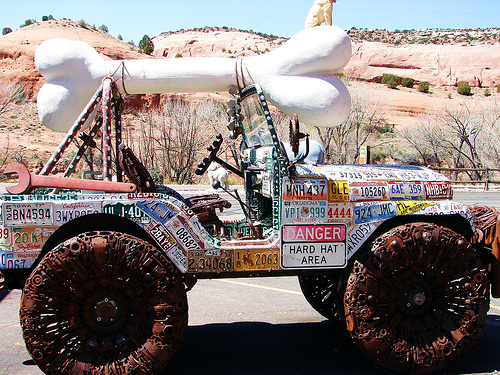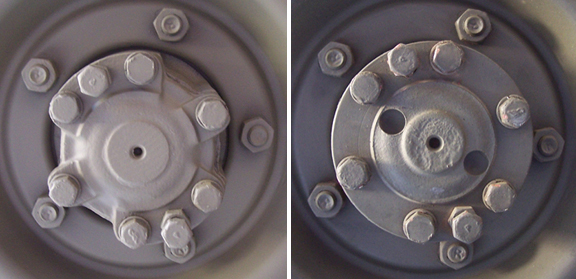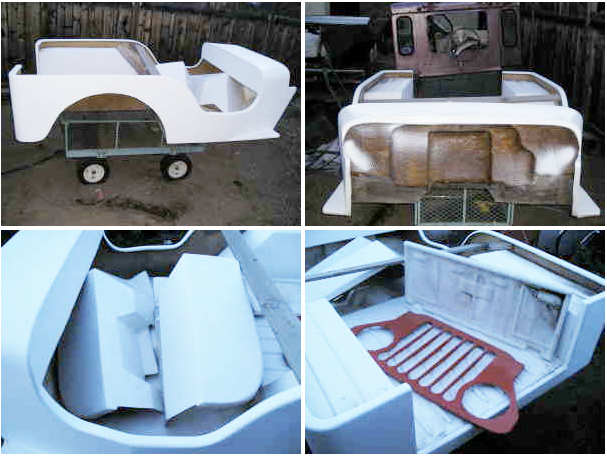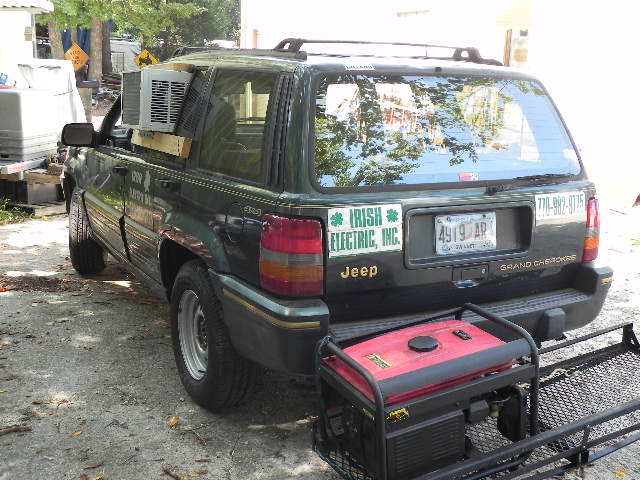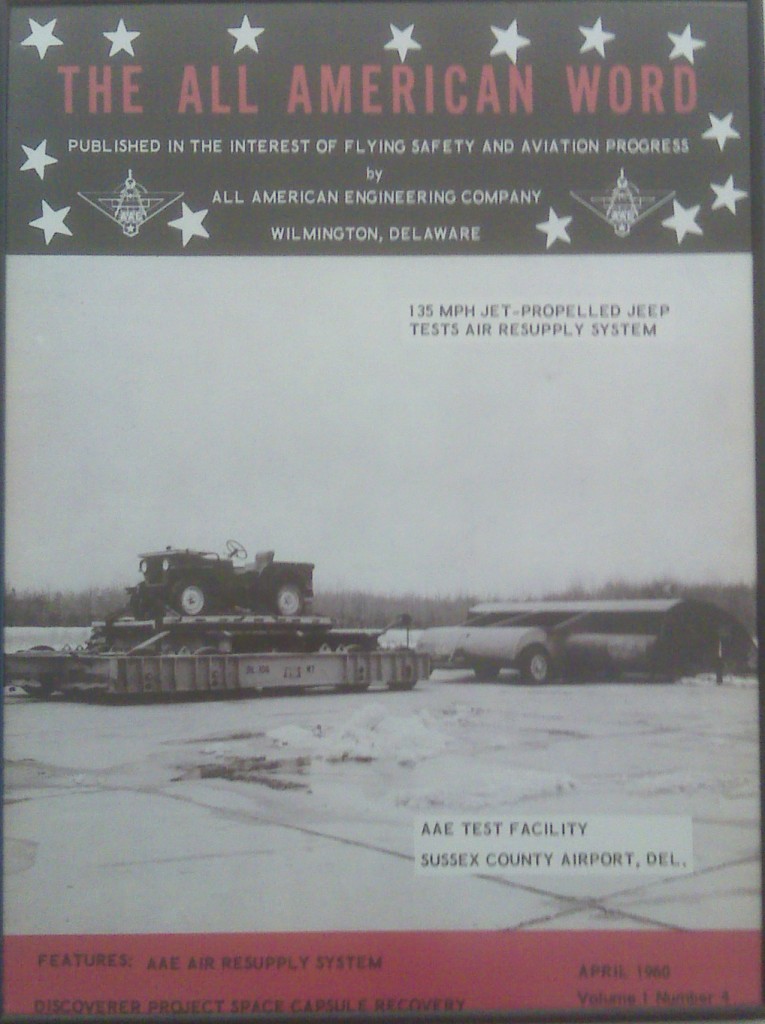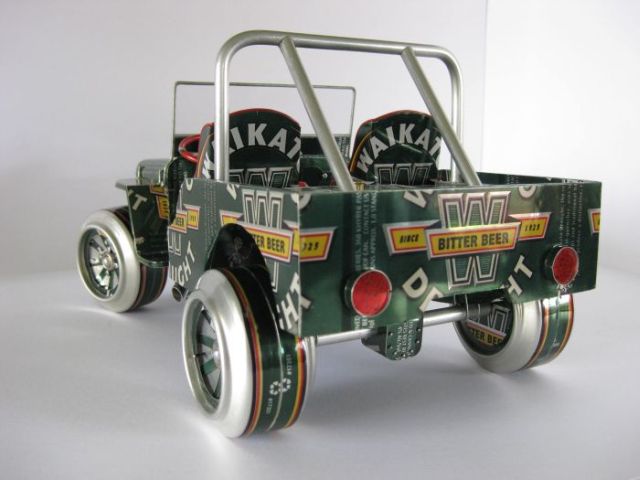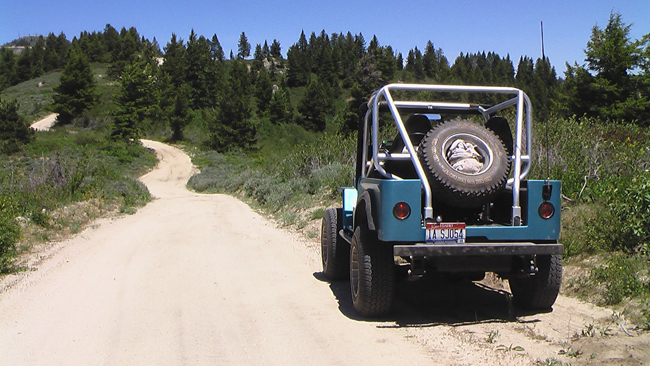Dexter is pretty excited about this find! No bad mods, though there appear to be a few things that need to be changed to make it closer to original. He should get an excellent stock MB out of it with some time. Below are a few pics and here are many, many pics. You can see a discussion about his find at the G503 site. Congrats Dexter!
Features Research Archives
Me and Dad Circa 1982 near Milk Lake, Wa
From the scrapbook archives comes this image of Dad and I readying ourselves for another day of jeeping. I believe this was in 1982 (which would make me 17 and dad 49). I remember the overnight at Milk Lake because we slept in the lean-to (see the blue tarp in the background), which was the first time I can remember doing that.
In the pics you can see the aluminum storage units with some supplies in them. Dad built those from Boeing Surplus leftovers, rivets and a rivet gun. They were light, easy to pack, and stored over the wheel wells, between the roll cage bars, so they were accessible on the trail as well.
Odd CJ-5
While looking for a clean example of the Willys Overland script, I came across an auto-created page, a page of complete jibberish that attempts to make the owner money by getting hits and advertising google and craigslist ads (therefore, I won’t provide a link). However, on this same page I found this odd CJ-5. It looks like the picture is somewhere in southern Utah. Anyone seen this elsewhere?
2 Webpages: Early MB Differences & British Airborne Jeep
I was looking up something for a reader when I stumbled upon these two webpages. One page documents some of the differences between very early MBs and later ones. The second page provides detail pics of a British Airborne Slatgrille in Signal Configuration. I thought both pages have nice detail pics and explanations.
The British Airborne Slat Grille in Signal Configuration:
The Early MB Differences Page:
A Reader Files a report from Thailand .. sort of …..
A reader named Bob was vacationing in Thailand when he spotted this pair of nicely restored MBs (one is a slat grille). An intrepid reporter, Bob captured the jeeps on video (download the video here — 11MB) which shows closeups of both jeeps and with a still image (seen below). He also talked briefly with the owner, Pete, who has two blotspot websites devoted to his Jeeps (the 1941 slat grille MB & the 1944 MB & Video of both Jeeps by Pete). Thanks for sharing Bob!
Bob filed this report, “I just came across these MB’s on the side of the road, as I was touring the island on a motorbike. I’m sorry I don’t have much info about Pete. I met him in the small bar across the street ( see in video with balloons across the front ) and we talked a little about the Jeeps. Pete emigrated to Thailand from the UK. He’s a really nice guy with a Thai wife and some kids. He claims you cannot import any of these Jeeps to Thailand anymore. I’m not sure if it is because of the Left Hand Drive or not. He said they are very valuable there too – worth over 1,000,000 Baht each ($31000 USD).”
Willys Jeep driven around Killymoon Castle in Northern Ireland
Randy forwarded me this video about a recreation of a 1943 drive in a Willys Jeep around Killymoon Castle, Cookstown, Northern Ireland. The folks at the Wartimeliving History Association helped make this video. The video is dedicated to the men of the 505th regimental combat team 82nd Airborne Division United States Army, Stationed in Cookstown Northern Ireland 9th December 1943 to 13th February. I don’t have any history about the original drive.
Original Bobcat Ad – and Bobcat Examples
As I have mentioned a few times, I grew up in the Wandering Willys Jeep Club. In 1971, the club lead an effort to record all the members from Clubs in Region one of the PNW4WDA, their names, addresses, phone number, jeep types, jeep names, their jobs, and assorted other info. As far as I know, this was the first and last directory of its type created.
One of my favorite finds in the directory was an early Ad for Bobcat Fiberglass bodies, complete with the watermark logo of a bobcat (which I didn’t notice until I scanned the ad). Below is the Ad with owner Fred Weis listed as the contact person. Apparently, sometime later Bobcat products were owned by H.C. Van Wagner, as shown by this business card embedded in one of my fenders (yes it is still there).
Below is the original Ad, followed by a later business card. One interesting bit of info is that I haven’t seen any Bobcat CJ-3B bodies (that I know of).
Here are some Bobcat Products:
This is supposed to be the first Bobcat body produced:
Here is an example of a raised hood:
Here’s a body .. note the wide rim around the rear edge of the body. Also, the step doesn’t cut in to the body at the end and there are no drain holes by the step. (similar to mine)
Here’s an example of the body that I purchased, which was a light body racer.
“Note the much wider edge (maybe 2” wide). This body was hacked up a little bit,
but hopefully cleaned up nicely for the guy who purchased it:
You Know We are in a Recession When ….
Kevin forwarded this to me (note the generator is sitting on a carrier behind the jeep) …
“The owner said to fix his factory installed a/c unit would cost more than the Jeep was worth…He had the generator for his work and used scap 2×4’s and screws from the job site,.. went to Brandsmart and bought the AC Unit for $88.00.”
The 135 MPH Jeep Test
As I mentioned a couple days ago, a reader named Dave spotted this article and wanted to share it with readers. The article published in the 1960 edition of All American Word follows the All American Engineering Company Testing the air drop of a jeep by a pallet rather than via a parachute. To test this concept, the AAE built a special vehicle to mimic the landing of a jeep atop a pallet at speeds of 135mph. As you can see, the test was successful (at least the one captured in the photos).
Dave writes,”I was in Georgetown, DE recently which is a small town on the DelMarVa peninsula, and I ran across this very interesting use for a VEC CJ2A! I think it might fit your recent “museum” series of posts and I’m sure that your eagle-eyed readers will immediately recognize the historical relevance of this column shift speed demon! Apparently, this was a precursor to what is now known as LAPES or the Low Altitude Parachute Extraction System which is still taught, practiced and used today by our Military for forward area resupply missions. I watched C130 crews practice this (with varying levels of success)! at Whiteman AFB in western Missouri in the late 80’s. Fortunately by that point they were only destroying HMMWVs and military pickup trucks! The 8 of 10 or so operations that were succesful were really cool and you could certainly see the advantages of this type of operation.”
Click on the link below to see some closeups
How and Why Was this Jeep Traveling at 135MPH?
Dave captured a variety of photos about an unusual use for a VEC CJ-2A. I’ll post more about this tomorrow night. For now, here’s a preview pic.
Prunedale, Ca $600
UPDATE: **SOLD** Was $600.
This is how NOT to stretch the front of the jeep to accomodate a longer frame ….
Paul Spots the Ultimate Radio Flyer
Just a couple updates tonight. The kids have me sufficiently worn out, so I’ll wait until tomorrow to add some listings.
Paul sent this awesome pic of the most unique radio flyer I have ever seen. Paul reports from Alaska, “Sunday, August first, I went to an outdoor car show even though the weather forecast predicted heavy rainfall. Naturally, with the low lying gray clouds and the expected rain the turnout was less than in years past but with the summer season drawing to a close there were still quite a few interesting cars, trucks and motorcycles but what caught my eye wasn’t any one of these. I’ve attached a picture of this impressive ehicle, just looking at the picture causes me to grin and when I watched it being driven down the road to the show I about fell over I was laughing so hard.”
Santa favors the Willys MA over the Red Sleigh
UPDATE: Brendan noted that this is indeed a LOC image. Here is a link to this image and others http://www.history.army.mil/photos/Holiday/wwii.htm.
I suspect it was just easier to stick the tree in the MA rather than his sleigh? It’s a great pic. I found this during an image search, but I could not locate the source. It looks like a Library of Congress type of image. If anyone knows of the source, please let me know so I can properly credit it.
Aberdeen US Army Ordinance Museum, Aberdeen PRV GRD, MD
Continuing with our museum series, Bill Maloney has captured a couple pics of this nicely restored 1943 GPW.
1946? CJ-2A Millsboro, De **SOLD**
UPDATE: **SOLD** Was on eBay.
(06/29/2010) The serial number of 130476 suggests this is a 1947 rather than a 1946.
“This is a ONE OF A KIND Vehicle. Its a 1946 CJ-2A Willy Jeep. It is tagged In Delaware as an antique vehicle. The body is handmade wood. It is the perfect vehicle for the beach. V-6 with extra transfer case and extra transmission. Tow bar so it can be towed behind your RV. In and out Locking Hubs. Sucicde Doors . Clear Title. Also log book of all work done and dates from original owner. Selling for a friend. Seller has the right to refuse sale and end auction at any time sitting for sale out side of residence. This is One of a Kind vehicle.”
Beer Can Flattie (and others)
UPDATE: Lylito pointed out that more information about these models and their New Zealand designer, Sandy Sanderson, can be read here. Plans are available, too. Jalopnik has also did a story about Sandy that includes details of the original drawings.
Randy forwarded me these amazing models. I’ve got more pics of the others and will forward them as an email.
Here are some other models (again, I have more pics of these if you are interested.
 Keywords: Aluminum Cans; Beer Cans;
Keywords: Aluminum Cans; Beer Cans;
Cadillac Ranch Motorsports
When I was a kid, jeep play/race days were held all over the Pacific Northwest. Whether at the sand dunes, in the forest, under some powerlines, in a boggy area of Everett or at an ORV park, it seemed the places a club could sponsor a playday were unlimited. For a variety of reasons, those days have passed and options for holding 4×4 events are limited.
This is why I was surprised to see a new area that allows some PNW racing (and motorcycle, trucks and atvs as well) called Cadillac Ranch MotorSports. From the website, “Cadillac Ranch Motorsports was started by three brothers who had some unused land that they decided to turn into a destination for excitement. Bring your ATV, motorbike, or truck to our track for a day of outdoor fun.” Check out some sprint racing pics here and some cross country pics here.
From the pics I saw on the website, a few friends and readers have already ventured down for some their outdoor fun, though I haven’t heard any feedback thus far. Even better, it’s only a stone’s throw from my sister’s place in McKenna, so I’ll have to swing by and check it out!
Here are some images from the Cadillac Ranch Motorsports website. This image shows the area in general, which looks great for spectating — you can see an entire run.
This is a pic from a sprint race:
And here are a couple pics from what I assume is a cross country course of some type. In the second pic you can see there is a pretty good line of racers ready to take their turn.
Some Updates …
For the Fourth of July, I celebrated by heading back to the formerly snow bound roads near Boise’ only ski area, Bogus Basin. As you can see in this pic, the snow is gone (see snow pics here), the mountains are now in bloom, and more progress was made. More on that tomorrow ….
A 1950 CJ-3A: Today, Darrel had to talk to me. So he stopped next to me, while I waited at a stop light, rolled down his window, and started asking me questions — what year was my jeep, who did my roll cage, and more …
Now, I had no idea who Darrel was. However, in the time it took for the stop light to finally change colors, Darrel had explained through his passenger side window that he A) liked what I had built, B) had a 1950 CJ-3A, C) wanted his jeep rebuilt for his daughter, D) had his jeep nearby, and E) wanted me to follow him there. If I learned that much at a stop light, I wondered how much I would learn about him once we stopped to see his jeep.
True to his word, he lived very close and had a 1950 CJ-3A that needed some work — hadn’t been run in 15 years. It had a V-8 conversion, solid body, rotted top and plenty of potential. And, to my surprise, based on my jeep, he asked me to do the work (and will pay me). I don’t have pics of this just yet. I’ll share more about this if we go forward with the project.
Brian wrote to me late last week to share a sad tale. As a part of the continued testing with his new build, he learned the hard way what happens if the oil in the front pumpkin housing gets too low AND the 4wd somehow gets accidentally shifted into gear (how that happened is still a mystery to him). The result: his front pinion started freezing up, resulting in some ugly sounds and a twisted driveline. See the pics to the right.
The good news is that everything else continues to behave well.
1973 CJ-5 Super Jeep Battle Creek, MI **SOLD**
Wes found this unusual, old school CJ-5 for sale at the Great Lakes Forum.
“1973 Super Jeep RARE BARN FIND 1 OWNER ,All the papers and doc.360 front and rear dana 44, 28,960.0 original miles Bought new and raced by factory employee.At the jeep proving grounds. Just very cool piece of history.check this out.$15,000. Or Make me a offer.”
I found this on Flickr ..
Upgrading a Single Master Cylinder into a Dual set up
A reader ask me about replacing the stock single brake master cylinder, found on many early jeeps, for a dual master cylinder. Can it be done? It turns out there a variety of threads and pages on this alteration. Here are some of the links I found if you are interested in this mod.
1) http://www.thecj2apage.com/forums/dual-master-cylinder_topic14193.html
2) http://www.earlycj5.com/forums/showthread.php?t=45099
3) http://cj3b.info/Tech/BrakesDualMaster.html
4) Herm’s conversion kit: http://www.hermtheoverdriveguy.com/id2_dual_reservoir_master_cylinder.htm
Usual Car/Jeep Custom Project
I ran across this today at the Jeep Forum. Posted last year, someone was trying to identify it. This is the closest thing I have seen to a Wally Cohn Jeep.
Gerald’s First Jeep — a $60 Commando
A reader had mentioned at some point about a modification that involved replacing the front clip of a Commando with a CJ-5 front clip. I asked for pictures and Gerald produced some from the first jeep he owned. I really like the looks of the CJ-5 front clip on it.
He writes, “Since you are talking Jeepsters, this was my first ride. I bought it for 60 bucks in October of 1979. That means it was only 11 years old; yet look how rough it was. Compare that to a 99 vehicle today. Vehicles have certainly improved. Anyway, I though I was the shit at 14 with my own jeep.”
We got her going with another axle, tiger hair and spray can red from K-Mart. Dad would take it to the trail and then I could drive.
Then at 18 came the lift, new body panels and paint. I had to knock the corners off the grille and put a CJ-5 Hood on it.
Unusual CJ-5 Rear Seat Mod
I was on my way to Jalopy Jungle (got some new springs — but that write-up must wait) in Nampa when I passed by this CJ-5 sitting outside an auto salvage shop in Meridian. As soon as I saw it, I made a quick u-turn and snapped some pics. The CJ-5 itself appears in stock condition with a solid body and no engine. There was no for sale sign and am not sure what it being done to it.
The rear seat itself it something I’ve never seen. The tail gate still works and there is storage area under the back seat.
Some Great Old Photos at JpZombie.com
At JpZombie.com, Casey has uploaded 20 images from the late 40s / early 50s. Several of the images have also been loaded at the earlycj5.com website and a thread has popped up around them. A video was also uploaded (see below) that shows early color footage of the Yakima Ridge Runners (from Yakima, Washington) playing in what appears to be the Little Naches River and shows them traveling over the Naches Trail (you can also see video excerpts from Exploration Northwest which discusses the trail).
Below is a small version of one of the pics at JpZombie. In this pic, you can see on the sign ‘Wally Klingele’, who was one of the founding members of the Ridge Runners. Some of the pics at JpZombie appear to be pics capturing the Life Magazine Folks who put together these classic videos (ridge runner video 1 & ridge runner video 2).
This is also courtesy of JpZombie.com via Youtube:
httpv://www.youtube.com/watch?v=t5eIbxvuKJQ





